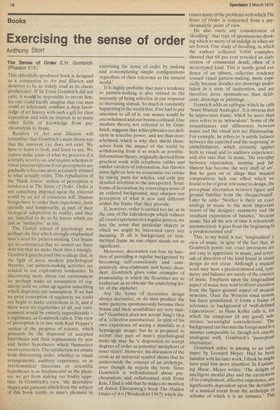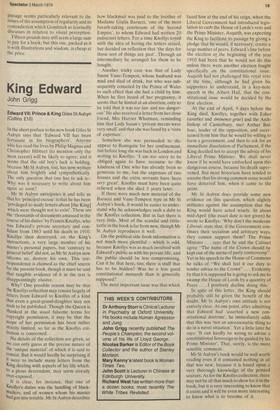Exercising the sense of order
Anthony Storr
The Sense of Order E.H. Gombrich (Phaidon £15) This splendidly-produced book is designed as a companion to Art and Illusion and deserves to be as widely read as its classic predecessor. If Sir Ernst Gombrich did not exist, it would be impossible to invent him; for one could hardly imagine that one man could so felicitously combine a deep knowledge of art history with such a gift for clear exposition and with an interest in so many other fields of knowledge from psychoanalysis to music.
Readers of Art and Illusion will remember that Gombrich's main thesis was that the innocent eye does not exist. We have to learn to look, and learn to see. We cannot make sense of what we perceive if it is totally novel to us, and require schemas or visual preconceptions if our perceptions are gradually to become more accurately attuned to what actually exists. This repudiation of the 'blank screen' notion of perception is reinforced in The Sense of Order. Order is not something imposed upon the external world by an act of conscious will. Human beings have to order their experience, both spatially and temporarily, as part of their biological adaptation to reality; and they are impelled to do so by forces which are just as 'instinctive' as sex.
The Gestalt school of psychology was perhaps the first which strongly emphasised man's need for pattern-making. Our brains are so constructed that we cannot see three dots but that we make them into a triangle. Gombrich goes beyond this to allege that, in the light of more modern psychological theories, our pattern-making activities are related to our exploratory tendencies. In discovering more about our environment we perhaps make an assumption of regularity until we come up against something which disproves our assumption. If we had no prior conception of regularity we could not begin to make corrections to it; and if there were no regularities at all, our environment would be entirely unpredictable — a nightmare, as Gombrich calls it. This view of perception is in line with Karl Popper's notion of the progress of science. which proceeds by the disproval of accepted hypotheses and their replacement by new and better hypotheses which themselves await correction. The satisfaction we obtain from discovering order, whether in visual arrangements, auditory experience, or in mathematical theorems or scientific hypotheses is as fundamental as the pleasure we get from slaking our bodily appetites. In Gombrich's view, 'the decorative shapes and patterns which form the subject bf this book testify to man's pleasure in exercising the sense of order by making and contemplating simple configurations regardless of their reference to the natural world.'
It is highly probable that man's tendency to pattern-making is also related to the necessity of being selective in our response to increasing stimuli. So much is constantly happening in the world that, if we had to pay attention to all of it, our senses would be overwhelmed and our brains confused. One modern theory, not referred to by Gombrich, suggests that schizophrenics are deficient in selective power, and are thus overwhelmed, which is why they shield themselves from the impact of the world by withdrawing from it as much as possible. Information theory, originally derived from practical work with telephone cables and similar carriers of information, has thrown some light on how we economise our intake by taking parts for wholes, and only pay detailed attention to the unexpected. Some forms of decoration, by conveying a sense of an ordered background, may sharpen our perception of what is new and different within the frame that they provide.
If, however, order is carried too far, as in the case of the kaleidoscope which reduces all visual experience to a regular pattern, we lose the sense that particular objects in which we might be interested carry any meaning. If all is background or symmetrical frame no one object stands out as significant.
Moreover, decoration can lose its function of providing a regular background by becoming self-consciously and competitively over-elaborate and hence decadent. Gombrich gives some examples of penmanship in which the flourishes are so exuberant as to obscure the underlying letter of the alphabet.
Are the forms of decorative design always derivative, or do men produce the same patterns spontaneously because their brains and their sensibilities are very similar? Gombrich does not accept Jung's idea of a 'collective unconscious', in spite of his own experience of seeing a mandala as a hypnagogic image: but he is prepared to accept that part of man's psychological make-up may be 'a disposition to accept degrees of order as potential metaphors of inner states'. However, his discussion of the cross as an universal symbol shows that he understands the concept of an archetype, even though he rejects the term. Since Gombrich is well-informed about psychoanalysis and collaborated with Ernst Kris, I find it odd that he makes no mention of Anton Ehrenzweig's book The Hidden Order of Art (Weidenfeld 1967) which dis cusses many of the problems with which The Sense of Order is concerned from a psychoanalytic point of view.
He also omits any consideration of 'doodling', that type of spontaneous drawing which so many of us indulge in when we are bored. One study of doodling, in which the authors collected 9,000 examples, showed that 60 per cent revealed an elaboration of ornamental detail, often of a stereotyped kind. This is surely good evidence of an inborn, collective tendency toward visual pattern-making, more especially because doodles are drawings undertaken in a state of inattention, and are therefore more spontaneous than deliberate drawings or paintings.
Gomrich adds an epilogue which he calls 'Some Musical Analogies'. It is obvious that he appreciates music, which he more than once refers to as 'miraculous'. Some of the resemblances and differences between music and the visual arts are illuminating. For example, he refers to 'a subtle balance between the expected and the surprising' in embellishment, which certainly applies both to visual and to auditory experience; and also says that, in music, 'the interplay between expectation, surprise and fulfilment has become the very stuff of art'. But he goes on to allege that 'musical compositions lack one effect which we found to be of great relevance to design, the perceptual alternation between figure and ground familiar from the chequerboard'. Later he adds: 'Neither is there an exact analogy in music to the most important resort of the designer, symmetry and the resultant expression of balance,' because music, like all the arts of time is relentlessly asymmetrical: it goes from the beginning to a predetermined end'. This, to my mind, is too, 'longitudinal' a view of music, in spite of the fact that, as Gombrich points out, exact inversions are not easy to appreciate in music, and reversals of direction of the kind found in visual design do not occur. Although a musical work may have a predetermined end, symmetry and balance are surely of the essence of music. Emphasis upon the longitudinal aspect of music may tend to divert attention from the figure-ground aspect of musical structure. Once the Western tonal system has been assimilated, it forms a frame of reference or background of 'well-defined expectations', as Hans Keller calls it, for which the composer (if any good) substitutes 'meaningful contradictions'. The background can become the foreground in a manner comparable to, though not exactly analogous with, Gombrich's 'perceptual alternation'.
Gombrich refers in passing to an earlY paper by Leonard Meyer. Had he been familiar with his later work, I think he might have paid him more attention. In Explaining Music, Meyer writes: 'The delight of intelligent mental play and the excitement of its complement, affective experience, are significantly dependent upon the deviation of a musical event from the archetype 0.1 schema of which it is an instance.' This passage seems particularly relevant to the issues of the assumption of regularity and its contradiction which Gombrich so learnedly discusses in relation to visual perception.
Fifteen pounds may still seem a large sum to pay for a book; but this one, packed as it is with illustrations and wisdom, is cheap at the price.



































 Previous page
Previous page